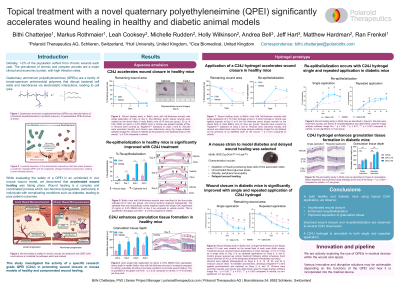Laboratory Research
(LR-010) Topical Treatment with Novel Hydrogel Containing Quaternary Polyethyleneimine (QPEI) Compounds Significantly Accelerates Wound Healing in a Preclinical Diabetic Animal Model

The prevalence of chronic and complex wounds is a significant public health issue requiring novel approaches to improving patient outcomes. Here, we evaluated the potential of newly developed hydrogels containing quaternary polyethyleneimine (QPEI) compounds to promote wound healing directly in a recognized healing-impaired in-vivo model.
Methods:
A single full-thickness wound (10 mm × 10 mm) was created on the dorsal flank of each male db/db mouse. Treatment groups received topical applications of QPEI (2 mg/mL or 4 mg/mL in 0.5% DMSO-H₂O) as a single dose on Day 0 or as repeated applications on Days 0, 4, and 8. Control groups received vehicle treatment (0.5% DMSO-H₂O) following similar schedules. Each wound received 30–40 μL of the designated treatment immediately post-injury.
Wounds were digitally photographed on Days 0, 4, 8, 12, 16, and 20 to measure closure rates. To facilitate assessments, dressings (Tegaderm film) were applied post-treatment and replaced on Days 4, 8, and 12.
On Day 20, wound tissues were harvested and analyzed for granulation tissue formation, re-epithelialization, and histological abnormalities. Animals received BrdU injections 1 hour prior to tissue harvest to enable immunohistochemical analysis of cellular proliferation. Tissues were processed, embedded, sectioned, and stained with H&E for digital imaging at 20× magnification.
Wound closure and histological outcomes were statistically compared between treatment and control groups. Granulation tissue depth and the percentage of re-epithelialization were quantified from scaled digital wound images and histological sections.
Results: Both single application (Day 0) and multiple applications (Days 0, 4 & 8) of QPEI hydrogel showed improved wound healing outcome demonstrated by enhanced wound contraction and re-epithelialization rates, contributing to faster wound closure. QPEI-treated wounds displayed significantly greater contraction and re-epithelialization from the first measurement post-wounding (day 4) onward. These findings were confirmed by histological analysis of wound tissues.
Discussion:
While QPEIs are known for their antimicrobial properties, this study is the first to report QPEI-mediated acceleration of wound healing in a preclinical diabetic wound model.
Further studies are essential to fully elucidate the QPEI mechanism of action. Here, we show that QPEI compounds demonstrate novel activity to promote wound healing, highlighting their potential to advance wound management and significantly improve patient outcomes.

.jpg)